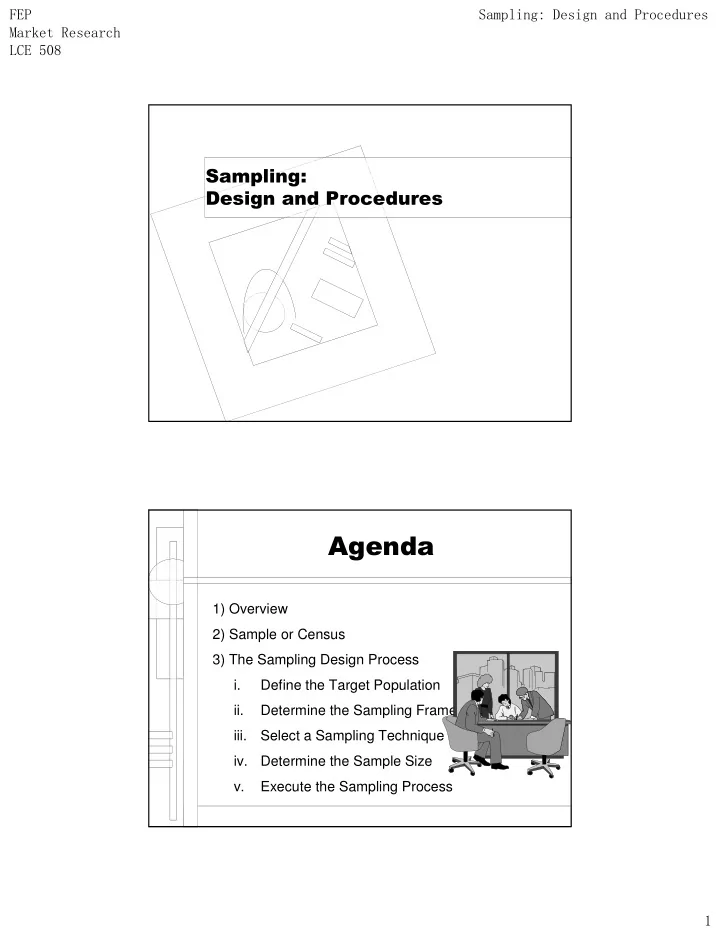

��� ������������������������������� ��������������� ������� ��������� ��������������������� ������ 1) Overview 2) Sample or Census 3) The Sampling Design Process i. Define the Target Population ii. Determine the Sampling Frame iii. Select a Sampling Technique iv. Determine the Sample Size v. Execute the Sampling Process �
��� ������������������������������� ��������������� ������� ������ 4) A Classification of Sampling Techniques i. Nonprobability Sampling Techniques a. Convenience Sampling b. Judgmental Sampling c. Quota Sampling d. Snowball Sampling ii. Probability Sampling Techniques a. Simple Random Sampling b. Systematic Sampling c. Stratified Sampling d. Cluster Sampling e. Other Probability Sampling Techniques ������ 5. Choosing Nonprobability versus Probability Sampling 6. Uses of Nonprobability versus Probability Sampling �
��� ������������������������������� ��������������� ������� ����������������� ������������������������������� ����������������������������������� ������������������������������� ���������� ���������������������������������� ������� ������������������������������ ������ ���������������������������������� ������� ���������������������������������� ������������������������ ������ �������������������������� �
��� ������������������������������� ��������������� ������� ����������������� Conditions favoring the use of SAMPLE CENSUS 1. Budget small high 2. Time available short Long 3. Population size large small ���������������������������������������������������� �������������������������������������������� �
��� ������������������������������� ��������������� ������� �������������������� ������� ��������������������� ���������������������������� ���������������������������� ������������������������� ���������������������������� ����������������� ������������������ ���������� ���������������������� ���������� ��������������������� ����������������� ���������������������� �������� ���������������� �������������� ��������������� �������������� ����������������������� ���������������������� ���������������������� ������ �������� �
��� ������������������������������� ��������������� ������� ������������������ ���������� The target population is the collection of elements or objects that possess the information sought by the researcher and about which inferences are to be made. The target population should be defined in terms of elements, sampling units, extent, and time. ����������������� – An element is the object about which or from which the information is desired: respondents, products, stores, companies, families,… – A sampling unit is an element, or a unit containing the element, that is available for selection at some stage of the sampling process. – Extent refers to the geographical boundaries. – Time is the time period under consideration. �
��� ������������������������������� ��������������� ������� ������������������ ��������� • Element: male or female head of the household responsible for most of the shopping at department stores • Sampling units: households; then male or female head of the household. • Extend: Porto • Time: November, 2004 ������������������ ��������� • Element: Male or female head of households • Sampling units: Working telephone numbers; then male or female head of households • Extend: Porto • Time: November, 2004 �
��� ������������������������������� ��������������� ������� ������������������ ��������� • Element: adults meeting three qualifications – Age 25 or older – Live in Algarve at least seven months of the year – Have a driver's license • Sampling units: household with a telephone number; then adults meeting the defined qualifications • Extend: Porto • Time: Period of the survey ������������������ ��������� • Element: Our product • Sampling units: Supermarkets, drugstores; then our product • Extend: Porto • Time: Period of the survey �
��� ������������������������������� ��������������� ������� ������������������ ��������� • Element: Chemical engineers • Sampling units: Companies purchasing over 300000€ of chemicals per year; then chemical engineers • Extend: Europe • Time: 2003 ������������������ ��������� • Element: Females 18-50 • Sampling units: Females 18-50 • Extend: Porto • Time: November, 2004 �
��� ������������������������������� ��������������� ������� ������������������ ��������� • Suppose that Revlon wanted to asses consumer response to a new line of lipsticks and wanted to sample females over 18 years of age. – a) it may be possible to sample females over 18 directly, in which case a sampling unit would be the same as an element; – b) alternatively, the sampling unit might be households; in the later case, households would be sampled and all females over 18 in each selected household would be interviewed; here, the sampling unit and the element are different. ��������� ���� • A representation of the elements of the target population. It consists of a list or set of directions for identifying the target population • Examples – telephone book – association directory listing the firms in an industry – a mailing list purchased from a commercial organization – a map ��
Recommend
More recommend